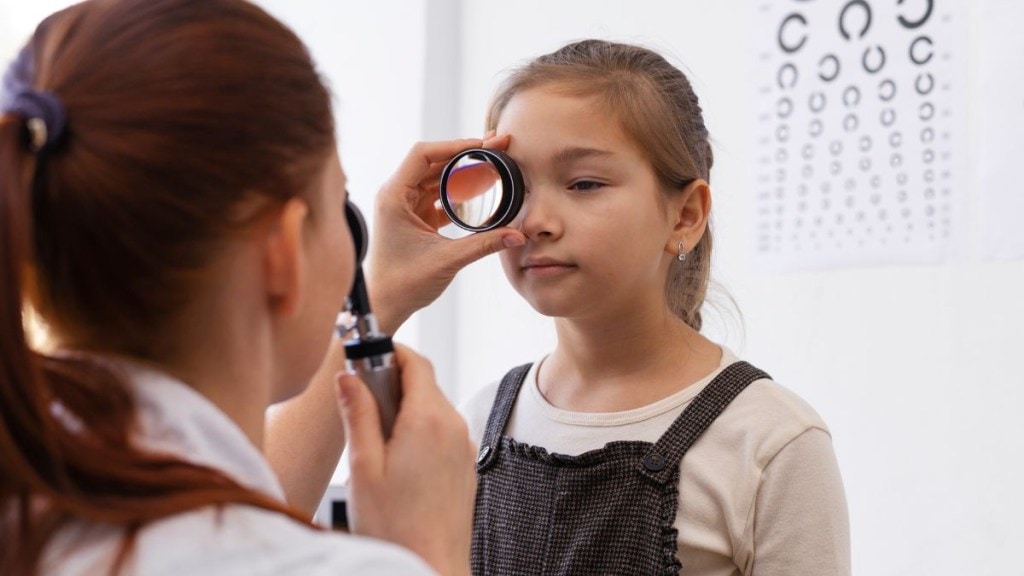As parents, you constantly juggle responsibilities, school drop-offs, homework, doctor visits, vaccination reminders, and everything in between. You do your best to meet every need of your children. But amid all this, there’s one important aspect of their health that often goes unnoticed: their eye check-up. It’s easy to assume that if your child isn’t complaining, their vision must be fine. But doctors warn this isn’t always the case.
“Children don’t always know what’s normal for their eyes,” explains Dr. Samir Sud, Co-founder and Medical Director, Sharp Sight Eye Hospitals. “A child may see clearly with one eye and poorly with the other, but because the brain adapts, they won’t realise something is wrong,” he further explains.
That’s why he advises that missing even one eye test can mean missing the chance to catch a problem early. In some cases, that single check-up could make the difference between a lifetime of clear vision and a lifelong struggle.
Kids don’t always say something’s wrong
Unlike adults, children often don’t realise when something is wrong with their eyesight. They may not notice blurry vision or poor depth perception, and sometimes one strong eye can hide the weakness of the other. This makes regular screening the only reliable way to detect problems early.
If vision problems are caught early, most can be treated or managed. But if they’re detected too late, the opportunity to correct them may be lost forever. What could have been solved with simple glasses or patch therapy might turn into a permanent challenge.
The risk of ‘lazy eye’
One of the most common but often overlooked eye problems in children is amblyopia, also known as ‘lazy eye.’ The eye doesn’t actually look lazy but instead, the brain begins to ignore signals from the weaker eye.
“If amblyopia isn’t detected before the age of 8 or 9, the affected eye may never develop normal vision,” says Dr. Sud. “Glasses or surgery won’t work if the brain has already shut down that pathway,” he further added.
The American Academy of Ophthalmology estimates that amblyopia affects 2–3 out of every 100 children worldwide. The condition is highly treatable in the early years but becomes very difficult to fix later.
Why school screenings aren’t enough
Many schools conduct basic eye check-up camps, but experts warn these are often limited. They usually test only distance vision and may miss issues like depth perception, eye muscle imbalance, or colour vision problems.
A report by the World Health Organization (WHO) shows that over 19 million children worldwide under the age of 15 are visually impaired, with many cases linked to conditions that could have been prevented with early screening.
“Parents should not rely only on school eye tests,” says Dr. Sud. “A proper check-up with a pediatric eye specialist gives a more complete picture of a child’s eye health.”
Digital overload and post-pandemic eye health
Today’s children spend more hours in front of screens than any generation before. Online classes, mobile games, and streaming videos mean long hours of close-up focus.
The COVID-19 pandemic made this worse, limiting outdoor play and increasing screen exposure. As a result, more kids are being diagnosed with myopia (nearsightedness) at younger ages.
A study published in JAMA Ophthalmology (2021) found that during the pandemic, cases of myopia in children aged 6 to 8 in China increased significantly, showing how lifestyle changes can quickly affect young eyes.
“Digital eye strain is no longer just an adult issue,” warns Dr. Sud. “We now see it in children as young as five or six.”
Signs parents should watch for
Sometimes, parents mistake vision problems for poor concentration or lack of interest in studies. But experts say the signs are often right in front of us. Squinting or tilting the head to see better, sitting too close to the TV, holding books too close, frequent eye rubbing, or complaints of headaches and eye pain can all point to trouble. “These subtle signs can directly affect a child’s learning, behaviour, and self-confidence,” says Dr. Sud. “If you notice them, it’s time for an eye check-up.”
How often should kids get their eyes tested?
According to the American Optometric Association (AOA) and the All India Ophthalmological Society (AIOS), children should have their first eye exam at the age of three, followed by another before starting school, around age five. After that, experts recommend an eye check-up every one to two years. For children who are born prematurely, have a family history of vision problems, or developmental delays, doctors advise starting screenings even earlier.
Clear vision leads to better learning
Strong eyesight is directly linked to academic performance and overall development. According to UNESCO, 80 per cent of a child’s learning is visual. If they can’t see the board or read comfortably, their education and confidence may suffer.
“Parents do everything to see their children successful. From good schools, healthy meals, to extracurriculars. But if a child can’t see properly, all of that can be affected,” says Dr. Sud.
A simple eye test, which takes only a few minutes, can save a child from decades of struggle. Experts say parents shouldn’t wait for complaints or assume school tests are enough.
“When it comes to children’s vision, proactive care is the only way forward,” says Dr. Sud. “Don’t wait for symptoms, act early,” he said.
So the next time you schedule vaccinations or dental check-ups, remember to add an eye test to the list. It could be the small step that shapes your child’s brighter future.

